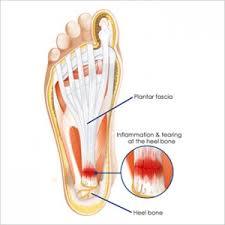
Karl Lockett
Clicking on the Send Me Details Now button opens an enquiry form where you can message Karl Lockett directly
If you are experiencing severe pain under the base of your heel you may wish to have your foot assessed by a sports podiatrist at the Sydney heel pain clinic.
Plantar Fasciitis
Focus areas
Arch pain
Scar tissue
Bursitis
Shin splints
Adults
Physical therapy
WHAT IS PLANTAR FASCIITIS?
Plantar fasciitis is painful inflammatory heel condition affecting people from all walks of life. It involves thickening and irritation of the plantar fascia under the base of the heel. The plantar fascia is a long ligament type structure that runs through the arch of the foot and passes five slips into each of the toes. Plantar fasciitis occasionally affects the midfoot and arch area but almost never affects the area underneath the toes. The majority of patients complaining of plantar fasciitis report the feeling of a stone bruise or a pebble in the shoe which causes severe pain underneath the base of the heel bone.
Most patients that have been diagnosed with plantar fasciitis report to the sports podiatrist that they experience most of their pain first thing in the morning when the foot touches the ground. Ordinarily, the heel pain tends to subside slightly or completely within the first 15 to 20 minutes of walking in the morning. The patient is able to get on with their day and take their morning shower and get ready for work and all the while the pain under the heel tends to drop off. However, patients with plantar fasciitis also reports something known as start-up pain, which can be described as discomfort or excruciating pain under the base of the heel after periods of being seated or driving. Once again, the pain under the heel begins to drop away the more the patient walks. Sometimes plantar fasciitis involves micro-tears or deep surface splitting of fibres. In these circumstances the pain is more severe and the heel pain condition can be described as being acute. In these circumstances, the patient will hobble and limp a lot more and will describe the pain as excruciating. They will often become more sedentary and avoid walking during their day-to-day activity.
WHO GETS PLANTAR FASCIITIS?
The majority of patients attending the Sydney heel pain clinic who have been diagnosed with plantar fasciitis are over the age of 40. This is not to say that people in their 20s and 30s do not develop plantar fasciitis, but there is a trend and many people are in their 60s and 70s. Their does seem to be an equal split between men and women and not all patients with plantar fasciitis are athletic. Every day walking and recreational jogging forms part of a common routine seen in patients with this complex heel pain condition. Plantar fasciitis can also be seen in patients who have been diagnosed with autoimmune conditions such as rheumatoid arthritis or ankylosing spondylitis. Menopausal women also suffer with plantar fasciitis due to drastic changes in hormones affecting soft tissue. When autoimmunity is involved, the symptoms seem to be more severe and most of the time both feet are affected. Ordinarily, plantar fasciitis affects only one foot.
WHAT ARE THE CAUSES OF PLANTAR FASCIITIS?
There are several causes and a variety of contributing factors to take into account when dealing with plantar fasciitis. One of the common causes is a sudden increase in physical activity following an extended period of inactivity. For example, the new get fit regime where by patients join Boot Camp or some other form of intense training programme. The patient goes from zero to hero in a short space of time which does not allow the body to become conditioned. Some of these patients are overweight and this increase in pressure on the feet leads to the plantar fasciitis. Patients who are carrying more bodyweight than they would like to often develop tight calf muscles. Regardless of body weight, tight calf muscles leading to ankle joint restriction is one of the most common findings in patients with plantar fasciitis. The calf muscles create an increased pulling sensation on the heel which in turn overloads the plantar fascia.
Another cause of plantar fasciitis is the use of incorrect shoes. Many patients are uninformed or misinformed and purchase the wrong type of shoe for their particular foot type. Skechers and Nike Free are two of the biggest culprits. These types of shoes are soft, comfortable and flexible which unfortunately means that they are non-supportive. These brands of shoe have been seen time and time again in patients who present with plantar fasciitis.
HEEL SPUR OR PLANTAR FASCIITIS?
Fortunately, there is now a greater understanding that plantar fasciitis causes heel pain not the heel spur itself. Previously, an x-ray would have been taken and a heel spur would be visualised. Understandably, this spiky piece of bone would have been the target for treatment and one would be forgiven for assuming the cause of pain. If the heel spur is extremely large and grows in the wrong direction, then they can be some discomfort and consideration of surgical intervention. However, at the Sydney heel pain clinic, the podiatrists focus on the plantar fasciitis and treat the heel pain accordingly. It is rare that the plantar heel spur needs treatment or any attention.
IMAGING FOR PLANTAR FASCIITIS
A thorough physical examination from a sports podiatrist is usually sufficient in order to accurately diagnose plantar fasciitis. Simple finger pressure in all the right areas commonly produce symptoms associated with this condition. The plantar aspect of the heel bone is a common site as is the medial aspect of the same heel bone. Therefore, medical imaging is not usually necessary when treating a new patient. However, ultrasound imaging can sometimes be helpful with plantar fasciitis when attempting to investigate the possibility of any other complications in this area of the foot. An x-ray is rarely requested as the heel spur is not the primary concern and the bone itself is rarely affected. Plantar fasciitis is a soft tissue injury therefore ultrasound imaging is adequate. An MRI is more detailed but is not usually necessary.
SHOES FOR PLANTAR FASCIITIS
Occasionally patients will ask the podiatrist for a specific shoe recommendation to treat their plantar fasciitis. Quite simply, there is no magic shoe or choice of footwear that can be relied upon to treat this condition. Footwear is normally tailored to each patient and the choice of shoe will be determined by the individual foot type of each person. As a general rule, slightly firmer shoes with less cushioning and less flexibility are more supportive and more beneficial for patients with plantar fasciitis.
Some patients will attempt to use a night brace or some form of sock in order to stretch out the bottom of the foot and reduce their symptoms of plantar fasciitis. Unfortunately, many of these gadgets are uncomfortable and the patient is unable to sleep properly with these in place. Patients often report to the podiatrist that the symptoms of plantar fasciitis are slightly better in the morning if they can get through the night with a brace in place. However, these devices do not contribute to healing and while the first few steps of the day are slightly easier, and the heel pain is a little less, the condition persists and does not heal due to the brace.
TREATMENT FOR PLANTAR FASCIITIS
The causes of plantar fasciitis are varied and therefore treatment of the condition is also multifactorial. There is no magic wand or magic bullet and each case is treated individually. Treatment for one person might not be appropriate for another and therefore the contributing factors in each patient must be noted prior to selecting a treatment or a combination of treatments. Some of the treatments that are commonly used are supportive treatments such as rigid sports tape or prescription orthotics. In patients with extreme pain and those who are struggling to walk without limping, the use of an immobilisation boot sometimes has its place.
When prescription orthotics are required for patients with plantar fasciitis the podiatrists at the Sydney heel pain clinic use carbon fibre due to its strength and support but also due to its streamlined and lightweight properties. This allows the orthotics to fit well into a variety of shoes including smaller style shoes and men's and women's office/court shoes. The high level of support that is received from these prescription orthotics allows the plantar fasciitis to recover naturally and heel quickly.
Some of the other treatments available at the Sydney heel pain clinic are shockwave therapy and dry needling. Shockwave therapy stimulates healing by increasing the number of blood capillaries in the area and stimulating the turnover new collagen cells in and around the plantar fascia. Research has shown that following each session of shockwave therapy there is an increase in vascularisation and these blood vessels can be seen forming under imaging.
If you have been diagnosed with plantar fasciitis or if you are experiencing severe pain under the base of your heel you may wish to have your foot assessed by a sports podiatrist at the Sydney heel pain clinic. Appointments can be made at any of our four locations across Sydney and the Western suburbs. The podiatrists are registered with all health funds and in certain circumstances can accept patients with a care plan from the GP.
Ultimately, plantar fasciitis is not a lifelong ailment such as arthritis. With the correct treatment and appropriate supportive intervention plantar fasciitis recovers within a matter of weeks.

Click on Send Me Details Now to get started
Send Me Details Now